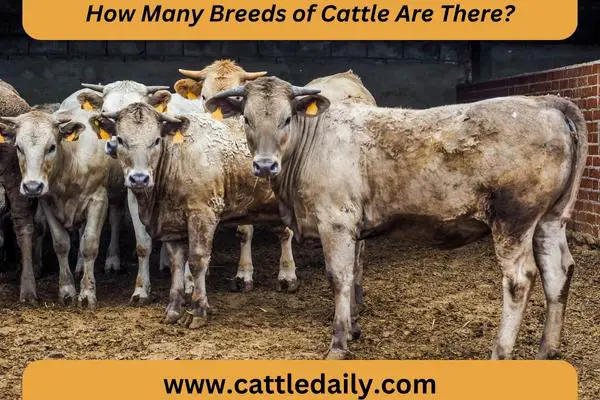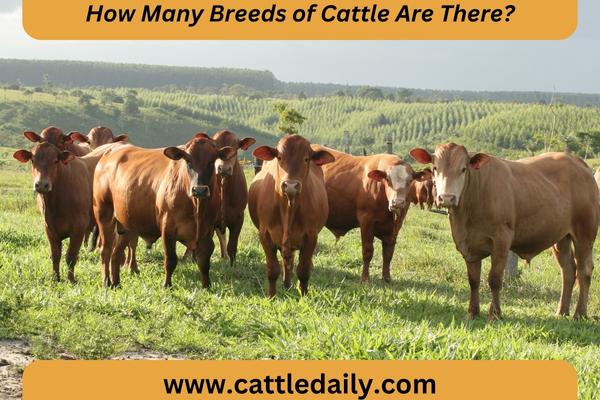How Many Breeds of Cattle Are There?
Cattle come in many different breeds, each with its own unique characteristics and uses. But just how many different cattle breeds exist worldwide? The number may surprise you.
There are currently over 800 identified breeds of cattle globally. However, the exact number is difficult to pin down as new breeds continue to be developed while some existing ones decline toward extinction.
The vast diversity in cattle breeds reflects the animal’s adaptability and selective breeding by humans across different regions and farming systems over thousands of years.
Understanding Cattle Breeds
Cattle breeds fall into two main types – Bos taurus and Bos indicus.
Bos taurus breeds originate from Europe, North America, and North Asia. They include common breeds like Holstein-Friesian, Angus, Hereford, and Jersey. Bos taurus adapted well to temperate climates and are primarily used for dairy and beef production.
Bos indicus br seeds come from South Asia, East Africa and South America. Examples include Brahman, Gir and Nelore. They thrive in hot, tropical areas and have higher heat tolerance. Bos indicus are valued for their hardiness, disease resistance and ability to produce beef in challenging environments.
Within these two cattle types, there is huge diversity in size, colour, horn shape, milk yield, carcass quality and other traits. Through selective breeding, farmers developed specialized breeds for dairying, meat production, draft work or even sporting uses.

Major Cattle Breeding Regions
Europe: Historically cattle domestication began around 8500 BC in regions like Anatolia and Ancient Greece. By Medieval times, distinct dairy and beef breeds emerged across Western Europe like Holstein, Red Angus, Limousin and Charolais.
India: Zebu cattle were domesticated here between 6000-4000 BC. Over time, heat-adapted Bos Indicus breeds developed including Gir, Ongole and Kankrej which spread across the tropics.
East Asia: Smaller taurine breeds were raised as draft animals and for meat like Wagyu and Korean Hanwoo. Hybrids with zebu also emerged.
Africa: Sanga cattle, an ancient hybrid, still exist along with breeds like Ankole-Watusi with huge horns. In West Africa, breeds adapted for meat and milk production like Muturu, Ndama and Kuri.
Americas: European cattle brought new genetics to the New World, mixing with creole breeds descending from Iberian stock. Over two centuries, breeds like Texas Longhorn, Beefmaster and Brangus emerged.
Australia: In the late 18th century, European cattle arrived from Britain and Ireland, crossing with zebu imports later on. Hardy breeds adapted to the outback like Droughtmaster and Belmont Red.
Global Population of Cattle Breeds
The global cattle herd is dominated by just a handful of breeds. According to the UN Food and Agriculture Organization (FAO), the top ten cattle breeds by population are:
- Holstein-Friesian: Originated in Europe, now the top dairy breed globally spread across 128 countries. Population: Over 46 million head.
- Brown Swiss: Another European dairy breed now present in over 100 countries. Population: Over 39 million head.
- Fleckvieh: Dual-purpose cattle from Bavaria, Germany used for both milk and meat. Population: Over 37 million head.
- Gir: A premier zebu dairy breed that originated in India with good heat tolerance. Population: Over 13 million head.
- Brahaman: Originated in the USA, a stabilized hybrid of zebu cattle with excellent tropical adaptation. Population: Over 13 million head.
- Angus: Originated in Scotland, a popular black meat breed with excellent marbling and meat quality. Population: Over 12 million head.
- Jersey: From the UK’s Isle of Jersey, known for its rich milk with high butterfat content. Population: Over 11 million head.
- Limousin: A French beef breed valued for its heavy muscling and lean red meat. Population: Over 10 million head.
- Japanese Black: A top Wagyu beef breed in Japan, produces exceptionally marbled beef. Population: Over 10 million head.
- Nellore: Originated in India, now Brazil’s main zebu breed, valued for its adaptability and hardiness. Population: Nearly 8 million head.

Rare and Endangered Breeds
While Holsteins, Angus and Brahmans dominate global cattle farming today, over one-third of the world’s cattle breeds are at risk. As commercial demand increased for dairy and beef production from high-output breeds, low-productively ones declined.
According to the FAO, an estimated 1 breed of cattle disappears each month, with over 200 breeds already extinct. This genetic erosion is a huge loss given that locally adapted breeds contain valuable traits.
Some endangered cattle breeds include:
- Gloucester: Once an iconic English dairy breed, less than 150 breeding females remain globally.
- Florida Cracker/Pineywoods: Descended from Spanish cattle brought to Florida in the 1500s by explorers. Fewer than 1000 purebred cows left.
- Randall Lineback: Originated in Vermont, USA, only 78 registered breeding females remain. Prized for its colorful spotted coat.
- Anu Roado: A sturdy triple-purpose breed from Estonia with only 4 breeding bulls remaining.
- Jutland: Denmark’s only native cattle breed has declined to just 1200 females, with ongoing conservation efforts to preserve it.
Many organizations now work to conserve rare cattle genetics before they are lost completely. Monitoring population trends helps assess a breed’s extinction risk.
While interbreeding with commercial cattle threatens purebred herds, well-managed crossbreeding can also preserve valuable genetics. Both strategies help maintain wider bovine biodiversity.
Conclusion:
With over 800 identified breeds worldwide, cattle demonstrate remarkable diversity. From the Arctic to the Sahara desert, bovine breeds adapted to serve our needs.
While relatively few dominate modern farming, the wider genetic spectrum allows cattle to thrive in varied environments and produce milk, meat, leather and draft power. Conserving this diversity preserves traits that can further sustainable food production into the future.
Humanity’s long history with cattle shaped the breeds we know today. However many older breeds now face extinction as agricultural systems intensified and homogenized.
Although impossible to save every lineage, maintaining bovine biodiversity ensures this iconic farm animal remains invaluable to communities across the planet.


